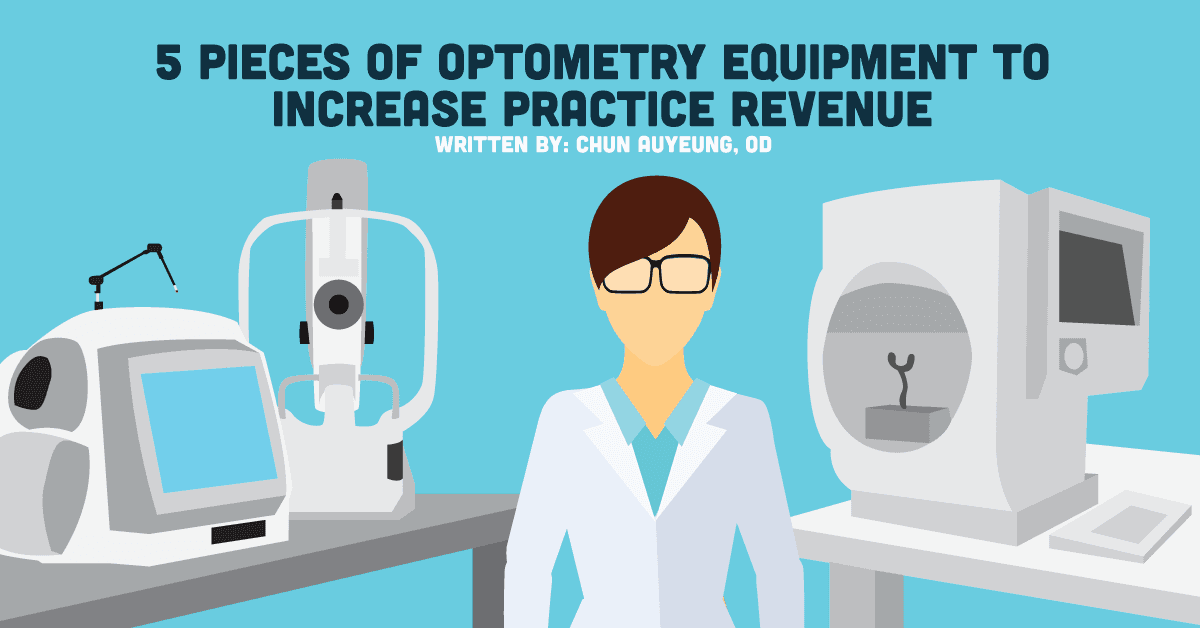As private practice ODs, we’ve got to wear what some might call a towering pillar of hats.
Today, we’re taking off the doctor hat and putting on the business hat. Or maybe just moving the doctor hat underneath the business hat for a little—just while we discuss practice revenue. Don’t worry, you can put the doctor hat on top again soon.
But while that doctor hat is hiding underneath the business hat, or sitting next to your computer, or whatever it’s doing, let’s talk about the 5 pieces of optometric equipment to increase practice revenue.
Obviously, the order of importance will vary depending on your patient demographics, geographic location, patient volume, blah, blah, blah...but let’s be real, patients love the retinal camera. And if they aren’t wowed by being shown a picture of their retina, well, what can you do? Some people are just boring.
Again, doctor hat off. Business hat on.
1) Retinal Photography
Seriously, the retinal camera is a hit. Not to mention the fact that they’re way more affordable these days; it’s almost like having an autorefractor.
Aside from the low cost, many practices generally get the retinal camera first before a visual field and OCT because it generates relatively high profit margin and high screening capture rates. This way, you can use it to fund your visual field and/or the OCT.
A retinal camera is mostly used as an add-on or screening option to a patient’s visit since the majority of our patients initially see us for vision-related exams. Retinal photography can be billed under medical insurance. The average Medicare reimbursement for retinal photography can vary by state, although I know I’ve seen some reimbursements around $70.00.
2) The Visual Field
The visual field is an excellent piece of diagnostic equipment and has long been a “Must Have” in offices. It can be used to diagnose and manage various neurological and retinal conditions, and plays a role anteriorly such as in the case of ptosis.
Medical insurance plans cover these procedure and depending on the diagnosis, its a test that can be billed several times a year. The average Medicare reimbursement for visual field is $65. The average cost of a visual field machine can vary dramatically depending on the kind of visual field machine you purchase and if it is new or used.
3) Optical Coherence Tomography (OCT)
The OCT’s technology and various features give the visual field a run for its money as the office “Must Have.” Since the OCT can be used to assess various locations of the eye (depending on model) — such as the optic nerve, macula, and the corneal angles, to name a few — it surpasses the visual field’s utilization. It’s like Oprah ordering the OCT for everyone!
The OCT’s price tag is a bit higher than that of a visual field machine, and if you have an OCT and retinal photography combination machine, prices can even be greater yet. The average Medicare reimbursement for OCT is $40.
4) Anterior Segment Photography
The anterior segment camera doesn’t get much love compared to the posterior segment camera. Maybe because it can’t be used as a “screening” option for insurance purposes. When utilized strategically, though, it can be profitable in the end. For example, you can use the anterior segment camera to show the level of blepharitis to your patient — which might prompt them to purchase lid hygiene kits from your office!
You can also use the anterior segment camera to present corneo-limbal neovascularization to a CLs abuser and switch them to a daily wear modality to avoid potential infections.
These cameras once again can vary dramatically in price depending on what kind of unit you are looking for. The average Medicare reimbursement for anterior segment photography is $20.
5) Topographer
The topographer is another piece of ophthalmic equipment that is not often used as a “screening tool.” It isn’t as sexy as the visual field, OCT, and retinal camera either, but it is similar to the aforementioned equipment such that it creates a niche for your practice as a specialty contact lens provider.
Not only is providing specialty contact lens services and materials a lot more profitable than regular contacts, it also ensures patients are returning to your practice yearly. The average cost of the topographer once again can vary dramatically while the average Medicare reimbursement for topography testing is $35.
Conclusion
In addition to your normal medical billing, when a patient presents for a vision examination, this equipment and the tests they provide can be offered to patients as a screening tool which comes with a fee. It can be priced as a la carte option or as a bundled option. This can provide a significant revenue increase to the average transaction per patient while providing optimal care with state-of-the-art technology. Who says we can’t wear the doctor AND business hat simultaneously?!
